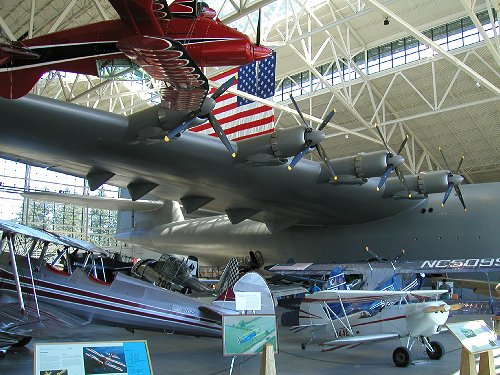Evergreen Flight Museum
Today, the Spruce Goose and river blindness. The University of Houston's College of Engineering presents this series about the machines that make our civilization run, and the people whose ingenuity created them.
It was a quiet week in Oregon -- family in Portland, high school reunion in Roseburg, a few days on that glorious coast. Before we headed back to the airport, someone reminded us that the famous Hughes Hercules, the Spruce Goose, had come to rest near McMinnville, along the way. Of course, we stopped by to see it.
The Spruce Goose is the largest airplane ever made. Howard Hughes and the Kaiser Company began it during WW-II as a long-range seaplane meant for moving heavy cargo -- 320-foot wingspan, sixty-five-ton payload, thirty-five-hundred-mile range. It's big.
It's made of wood (mostly birch, but birch doesn't rhyme with goose) and it has fabric-covered control surfaces. It's an anachronism, but not because of wood and fabric. By the late 1930s, land-based airplanes with retractable landing gear finally had range and power to cross oceans and carry a payload as well.
But a seaplane also has to carry its own boat -- either a fat floating fuselage or unretractable pontoons. Either yields a high-drag, slow-moving airplane. The Goose, with its thirty-foot high body, would've cruised at less than two hundred miles an hour.
The Kaiser Company had already pulled out when Howard Hughes finally taxi-tested the airplane in 1947. He unexpectedly lifted off and flew to a height of forty or seventy feet (depending on whether you count the hull or the pilot's seat). He showed the world that it flew and then mothballed it.
 Now I enter the museum. As I gape at the monster, I don't notice the chairs and podium beside it. Then, a tap on my shoulder: "Hi, John, didn't know you'd be at the dedication!" It's a colleague from Oregon State University. At just this moment, the American Society of Mechanical Engineers is naming the Goose as a historical landmark. For it is an engineering masterpiece.
Now I enter the museum. As I gape at the monster, I don't notice the chairs and podium beside it. Then, a tap on my shoulder: "Hi, John, didn't know you'd be at the dedication!" It's a colleague from Oregon State University. At just this moment, the American Society of Mechanical Engineers is naming the Goose as a historical landmark. For it is an engineering masterpiece.
I wander among the many other airplanes, like butterflies in the Goose's shadow -- WW-I airplanes, a beautiful Ford Trimotor, a Spitfire, a Piper Cub. An old pilot is standing by the B-17. "I flew 35 missions," he says. "Then, one day, an explosion, and this went rattling through my cockpit." He shows me a nasty piece of flak and adds, "I said, 'Thank you, God,' and put it in my pocket."
In any case, Disney put the Goose on display at Long Beach in 1960 and lost money on the venture. Finally, Evergreen International Aviation offered to take it. They broke it down and reassembled it in this glass and steel building in Oregon vineyard country.
Evergreen has an airline, makes helicopters, owns orchards, farms, nurseries, and much more. Evergreen's Humanitarian and Relief Services are heavily involved in providing air support in the struggle to eradicate river blindness across equatorial Africa.
In the end the pieces fit together. It all feels like a throwback to the off-the-wall drama and idealism of early-twentieth-century flight. A strange epoch lost, and, for a moment, a strange epoch reclaimed.
I'm John Lienhard, at the University of Houston, where we're interested in the way inventive minds work.
(Theme music)
For more on the Evergreen Museum see: http://www.evergreenmuseum.org/
